Onion: Grow & Care for Onion Plants-A Complete Growing Guide
Written by Iris
Dec 13 2022
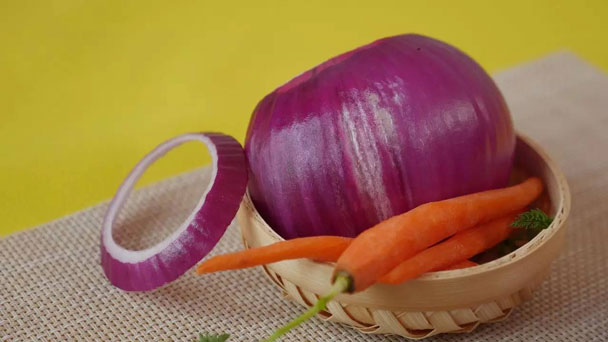
Onion (Allium cepa), a biennial herb of the Lycoris family (lycoraceae) cultivated for its edible bulbs. Onions are low in nutrients but are valued for their flavor and are widely used in cooking. They add flavor to dishes such as stews, roasts, soups and salads, and can also be eaten as cooked vegetables. Onions may have originated in southwest Asia, but they are now grown all over the world, mainly in temperate regions. The common onion has one or more leafless stems that reach 75-180 cm (2.5-6 ft) in height and end in a cluster of small spherical flowers.
At planting time, add about an inch of compost to the bottom of each row before planting. Or, dig a trench in the soil about 2 inches deep and 3 inches wide, and then fill the trench back in with about an inch of compost. Practice crop rotation with onions. In other words, don't plant them in the same location year after year, as this can encourage the spread of diseases that affect the crop. Learn more about crop rotation.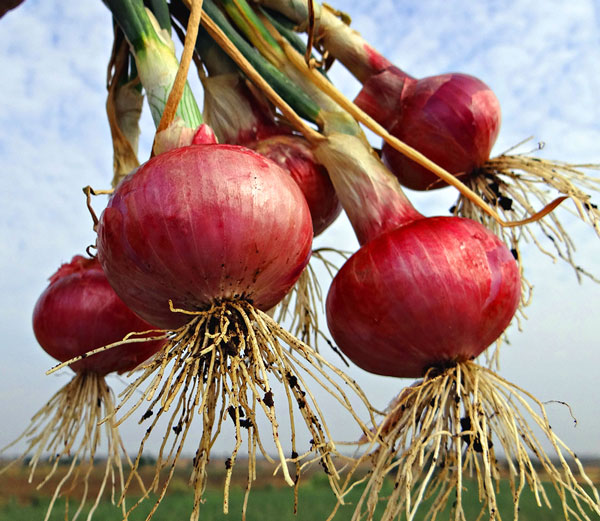
A fall-planted crop of onions needs at least 4 to 6 weeks of warm temperatures to become established in the ground. They will remain dormant during the cool season, but be all primed and ready to grow when spring arrives. Fall onions often grow much larger and better-tasting than same-year planted onions.
In regions with a frigid winter, it's best to plant onion sets in the spring as soon as the ground can be worked—usually in March or April. Ideally, time your planting so that outdoor temperatures no longer dip below 28°F (-2°C) after the onions are in the ground.
Fall-planted onions are a great way to enjoy an earlier and larger bulbed harvest from next year's garden. Plant in the warm autumn soil so that they may establish a strong root system before winter sets in. As the cold chill of winter arrives, the crop goes dormant. Then, as the temperatures and soil warm again in early spring, the onions come back to life.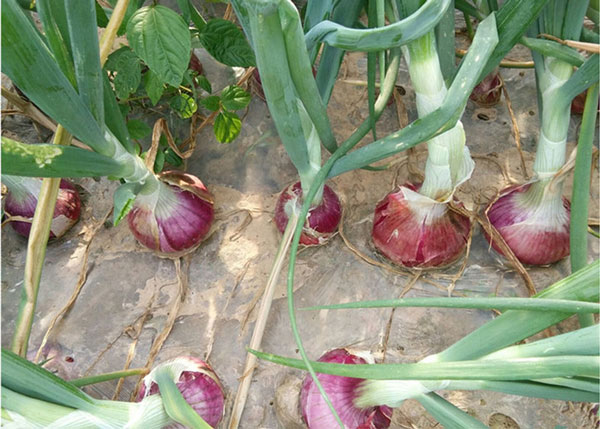
The soil should be moist before sowing so check the soil the day before sowing and water if the soil is dry.
If planting onion sets then they can be planted around Mid to Late March (earlier if a cloche / polytunnel is used). Again space rows about 30cm apart. Sow sets around 10cm apart as they shouldn't require any thinning. Dig a small hole for each set and place the set in neck upwards. When covered back up with soil the tip of the neck should just show through the soil surface.
Spring onions (scallion) can be sown from April and planting should be staggered every few weeks to ensure a continuous crop throughout the growing season.
Before planting in spring, dig over the plot, clearing it of all weeds and stones. Tread down the soil and rake it to produce a level surface with a light, crumbly texture.
A couple of weeks before planting, rake in 35g/m2 of granulated fertiliser or 75g/m2 of dried chicken manure pellets. If you weren’t able to dig in compost or manure in autumn, then double the amount of fertiliser used.
Plant onion sets 20cm (8in) apart, with the tips just showing above the soil. Allow 30cm between rows.
Water in after planting – this helps to settle the soil around the bulbs.
Cover the area with netting to stop birds pulling up the young plants.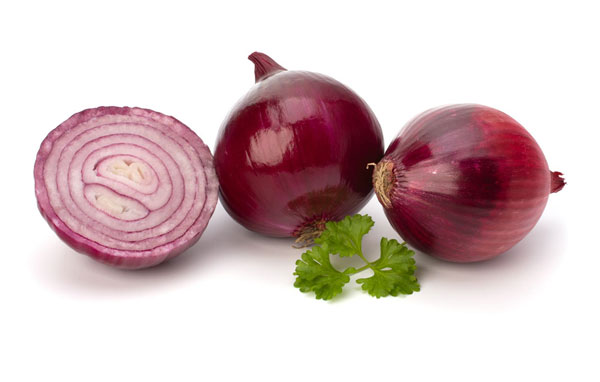
Varieties of Onion
There are three types of onions you can choose from. Onion sets or transplants purchased at a local garden center will usually be appropriate for your climate, but when buying mail-order seeds, make sure to choose the right variety based on your climate:
Short-day onions will begin forming bulbs when there are 10 to 12 hours of daylight each day. They work well in southern regions where summer daylight is comparatively short. Some common short-day onions include 'Southern Belle', 'White Bermuda', 'Granex', and 'Cipollini'.
Long-day onions begin forming bulbs when there are 14 to 16 hours of daylight per day. They are good for northern climates where the summer days are relatively long. Some recommended long-day onions include 'Walla Walla', 'Ring Master', 'Red Zeppelin', 'Yellow Sweet Spanish', 'Italian Red Torpedo', and 'Redwing'.
Day-neutral onions begin to form bulbs when they experience 12 to 14 hours of daylight each day. They are good for gardeners in the central U.S. Good varieties include 'Red Amposta', 'Early Yellow Globe', 'Cabernet', and 'Superstar'.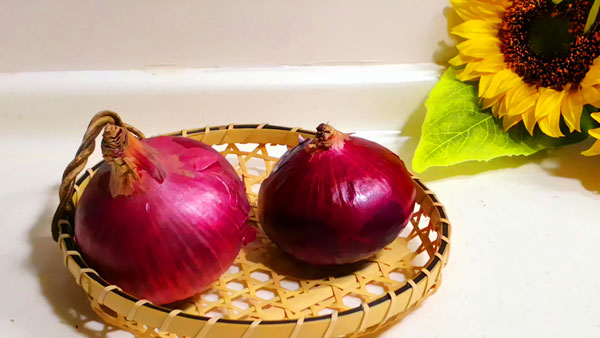
Fill a pot with garden soil. Make a hole in the middle of the pot. The size of the hole should be about the depth and width of the onion.
Now, place the onion that you want to plant in the hole. After that cover the onion with soil.
Water the pot and place it where it will receive enough sunlight
Now the green sprouts are ready for harvest. Harvest them whenever you need them for cooking.
If you see a sprout with a flower, don’t harvest it. wait until the flower converts into a seed. You can use this seed for planting during the spring season.
When onions begin to mature, the tops (foliage) become yellowish and start to fall over. At that point, bend the tops of onions down or stomp on them to speed up the final and last ripening process.
Try loosening the garden soil around the bulbs to speed up the drying.
When tops of onions are brown, pull them.
Make sure to harvest the onions in late summer, just before cool weather. Mature and fully grown onions may spoil in fall weather.
How to Choose and Prepare a Planting SiteWhen to Grow OnionHow to Grow OnionSteps for Onion Propagation with SeedsSteps for Onion Propagation with OffsetsHow to Care for OnionLightSoilWaterTemperature and HumidityFertilizerPests and DiseasesOnion FAQCan you Plant a Sprouted Onion?When to Harvest Onions?
How to Choose and Prepare a Planting Site
Growing great onions, whether in the spring or fall, all starts with soil that is well-drained, loose, and fertile. Compacted, rocky, or clay-heavy soil will affect bulb development and result in subpar onions. If you live in an area with heavy clay or hard soil, add in aged compost (humus) to improve soil texture. Contrary to popular belief, adding sand will only make it worse! Read more about preparing soil for planting. Add aged manure or compost to the soil in the fall or early spring. Onion plants are heavy feeders and need constant nourishment to produce big bulbs. Select a location with full sun, where your onions won't be shaded by other plants. The more energy they can get from the sunlight, the larger their bulbs can grow.At planting time, add about an inch of compost to the bottom of each row before planting. Or, dig a trench in the soil about 2 inches deep and 3 inches wide, and then fill the trench back in with about an inch of compost. Practice crop rotation with onions. In other words, don't plant them in the same location year after year, as this can encourage the spread of diseases that affect the crop. Learn more about crop rotation.

When to Grow Onion
Onions can be planted in both the spring and fall seasons, depending on where you live. Generally speaking, plant onion sets outdoors when the weather is cool—not cold. And you can grow onion with Celery for better growth.A fall-planted crop of onions needs at least 4 to 6 weeks of warm temperatures to become established in the ground. They will remain dormant during the cool season, but be all primed and ready to grow when spring arrives. Fall onions often grow much larger and better-tasting than same-year planted onions.
In regions with a frigid winter, it's best to plant onion sets in the spring as soon as the ground can be worked—usually in March or April. Ideally, time your planting so that outdoor temperatures no longer dip below 28°F (-2°C) after the onions are in the ground.
Fall-planted onions are a great way to enjoy an earlier and larger bulbed harvest from next year's garden. Plant in the warm autumn soil so that they may establish a strong root system before winter sets in. As the cold chill of winter arrives, the crop goes dormant. Then, as the temperatures and soil warm again in early spring, the onions come back to life.

How to Grow Onion
Steps for Onion Propagation with Seeds
If sowing from seed then sow in drills about 2cm deep with about 1 inch between seeds. If sowing in rows then space the rows about 30cm apart.The soil should be moist before sowing so check the soil the day before sowing and water if the soil is dry.
If planting onion sets then they can be planted around Mid to Late March (earlier if a cloche / polytunnel is used). Again space rows about 30cm apart. Sow sets around 10cm apart as they shouldn't require any thinning. Dig a small hole for each set and place the set in neck upwards. When covered back up with soil the tip of the neck should just show through the soil surface.
Spring onions (scallion) can be sown from April and planting should be staggered every few weeks to ensure a continuous crop throughout the growing season.
Steps for Onion Propagation with Offsets
Although you can grow onions from seed, it’s simpler to grow them from sets. Sets are young onion bulbs, grown especially for planting.Before planting in spring, dig over the plot, clearing it of all weeds and stones. Tread down the soil and rake it to produce a level surface with a light, crumbly texture.
A couple of weeks before planting, rake in 35g/m2 of granulated fertiliser or 75g/m2 of dried chicken manure pellets. If you weren’t able to dig in compost or manure in autumn, then double the amount of fertiliser used.
Plant onion sets 20cm (8in) apart, with the tips just showing above the soil. Allow 30cm between rows.
Water in after planting – this helps to settle the soil around the bulbs.
Cover the area with netting to stop birds pulling up the young plants.

How to Care for Onion
Light
Onions need plenty of sunlight - at least six hours a day - to grow properly. With Onions, the more sunlight, the better.Soil
Onions will grow in almost any soil from sandy loams to heavy clay. The soil should be firm. If your soil is heavy then you can introduce some organic compost or manure into the soil to help its moisture retaining properties. Onions prefer a slightly acidic soil - PH 5.5-6.5 is a good PH for growing onions.Water
Onions need regular watering to support bulbous expansion. Water them an inch a week, but don't overwater or leave the bulbs sitting in wet soil, as this can cause them to rot.
Temperature and Humidity
One reason Onions are considered somewhat difficult to grow is that they are cold-season vegetables, but take a considerable time to mature (90 days or more). Moreover, they don't really start to grow well until outdoor temperatures average around 50 degrees.Fertilizer
Onions are quite heavy for breeders. Fertilize them every few weeks with a high-nitrogen fertilizer to support leaf growth, which will produce large bulbs (onion bulbs are actually modified leaf structures). Stop feeding where onion bulbs begin to push away the soil.Pests and Diseases
- Thrips
- Onion Maggots
- Onion fly
- Onion white rot
Varieties of Onion
There are three types of onions you can choose from. Onion sets or transplants purchased at a local garden center will usually be appropriate for your climate, but when buying mail-order seeds, make sure to choose the right variety based on your climate:
Short-day onions will begin forming bulbs when there are 10 to 12 hours of daylight each day. They work well in southern regions where summer daylight is comparatively short. Some common short-day onions include 'Southern Belle', 'White Bermuda', 'Granex', and 'Cipollini'.
Long-day onions begin forming bulbs when there are 14 to 16 hours of daylight per day. They are good for northern climates where the summer days are relatively long. Some recommended long-day onions include 'Walla Walla', 'Ring Master', 'Red Zeppelin', 'Yellow Sweet Spanish', 'Italian Red Torpedo', and 'Redwing'.
Day-neutral onions begin to form bulbs when they experience 12 to 14 hours of daylight each day. They are good for gardeners in the central U.S. Good varieties include 'Red Amposta', 'Early Yellow Globe', 'Cabernet', and 'Superstar'.

Onion FAQ
Can you Plant a Sprouted Onion?
Yes, you can always plant a sprouted onion. But you will not get many onions from it. However, you will get lots of tasty and delicious green sprouts. Here's how you can do it.Fill a pot with garden soil. Make a hole in the middle of the pot. The size of the hole should be about the depth and width of the onion.
Now, place the onion that you want to plant in the hole. After that cover the onion with soil.
Water the pot and place it where it will receive enough sunlight
Now the green sprouts are ready for harvest. Harvest them whenever you need them for cooking.
If you see a sprout with a flower, don’t harvest it. wait until the flower converts into a seed. You can use this seed for planting during the spring season.
When to Harvest Onions?
Pull out all the onions that send up flower stalks. Flowers stalks indicate that the onions have reached maturity and have stopped growing. It is difficult to store these onions for long. But we can use them in our homes for a few days.When onions begin to mature, the tops (foliage) become yellowish and start to fall over. At that point, bend the tops of onions down or stomp on them to speed up the final and last ripening process.
Try loosening the garden soil around the bulbs to speed up the drying.
When tops of onions are brown, pull them.
Make sure to harvest the onions in late summer, just before cool weather. Mature and fully grown onions may spoil in fall weather.
Latest Updated
- Benefits of Bugleweed - 7 Science-backed Health Benefits
- Bugleweed Dangers & Side Effects - Is It Poisonous?
- How to Plant Evergreen Trees - What You Should Know
- When to Plant Evergreens - Grow Guide for Evergreen Trees
- 12 Wonderful Evergreen Shrubs for Your Garden
- 12 Popular Evergreen Plants with Pictures for Beginners
- When And How To Prune A Lilac Bush Like a Pro
- How to Grow & Care for Lilac Vine (Hardenbergia Violacea)
- Japanese Lilac Tree (Syringa Reticulata) Care & Propagation Guide
- Shumard Oak Pros and Cons - What to Know
Popular Articles
- Winter maintenance of Antirrhinum Majus
- How to Grow Terminalia Mantaly Tree
- How to Grow and Care for Crossostephium Chinense
- How to grow Antirrhinum Majus in spring
- Peristeria Elata (Dove Orchid) Profile: Info & Care Guide
- Underwatered Snake Plant (Sansevieria Trifasciata) - Signs And How To Fix
- How to Care for Brazilian Jasmine Plant (Mandevilla Sanderi)
- How to Grow & Care for Graptopetalum Purple Delight in Summer
- Rosa Chinensis (China Rose): Plant Growing & Care Tips
- How to Care for Baby Sun Rose (Aptenia Cordifolia)